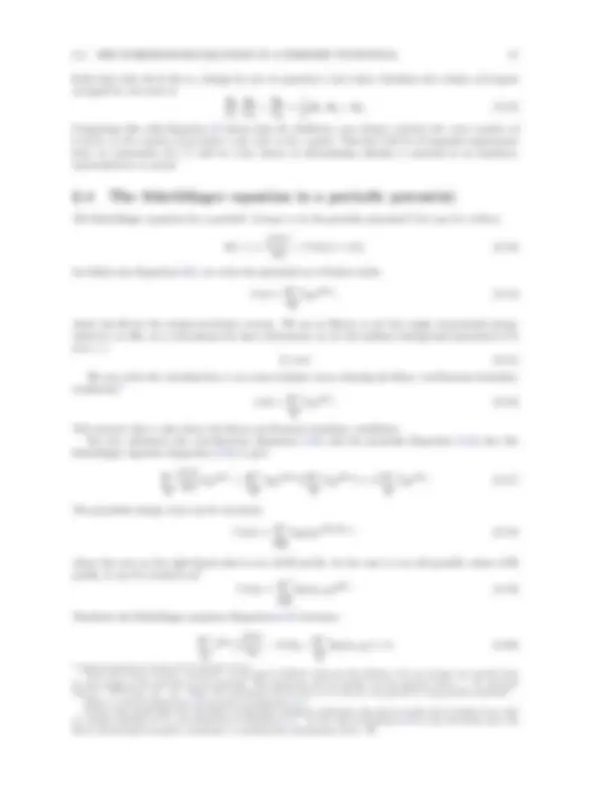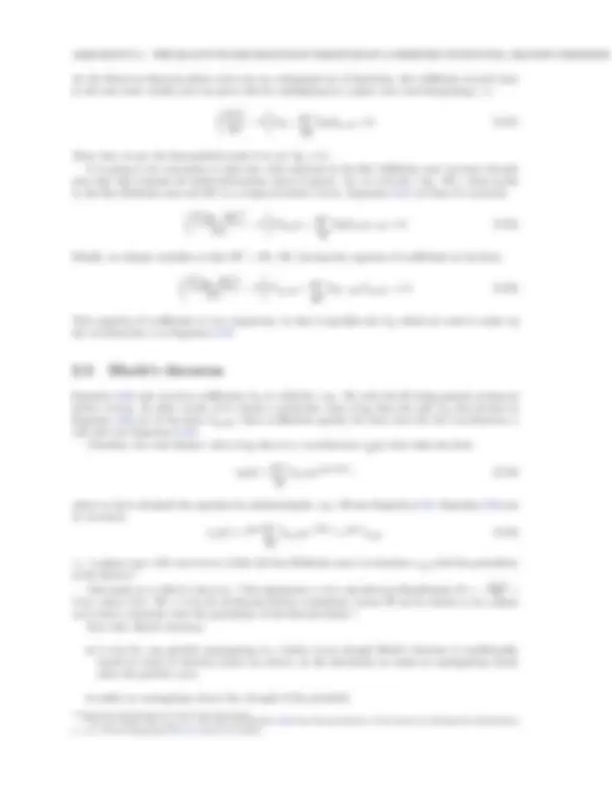





Study with the several resources on Docsity

Earn points by helping other students or get them with a premium plan


Prepare for your exams
Study with the several resources on Docsity

Earn points to download
Earn points by helping other students or get them with a premium plan
Community
Ask the community for help and clear up your study doubts
Discover the best universities in your country according to Docsity users
Free resources
Download our free guides on studying techniques, anxiety management strategies, and thesis advice from Docsity tutors
You will learn about Bloch’s theorem using given solutions.
Typology: Study notes
1 / 5

This page cannot be seen from the preview
Don't miss anything!




We are going to set up the formalism for dealing with a periodic potential; this is known as Bloch’s theorem. The next two-three lectures are going to appear to be hard work from a conceptual point of view. However, although the algebra looks complicated, the underlying ideas are really quite simple; you should be able to reproduce the various derivations yourself (make good notes!). I am going to justify the Bloch theorem fairly rigorously. This formalism will then be used to treat two opposite limits, a very weak periodic potential and a potential which is so strong that the electrons can hardly move. You will see that both limits give qualitatively similar answers, i.e. reality, which lies somewhere in between, must also be like this! For this part of the course these notes provide a slightly different (Fourier) approach to the results that I will derive in the lectures. I recommend that you work through and understand both methods, as the Bloch theorem forms the foundation on which the rest of the course is based.
We have been treating the electrons as totally free. We now introduce a periodic potential V (r). The underlying translational periodicity of the lattice is defined by the primitive lattice translation vectors
T = n 1 a 1 + n 2 a 2 + n 3 a 3 , (2.1)
where n 1 , n 2 and n 3 are integers and a 1 , a 2 and a 3 are three noncoplanar vectors. 1 Now V (r) must be periodic, i.e. V (r + T) = V (r). (2.2)
The periodic nature of V (r) also implies that the potential may be expressed as a Fourier series
V (r) =
G
VGeiG.r, (2.3)
where the G are a set of vectors and the VG are Fourier coefficients.^2 Equations 2.2 and 2.3 imply that
eiG.T^ = 1, i.e. G.T = 2pπ, (2.4) (^1) See Introduction to Solid State Physics, by Charles Kittel, seventh edition (Wiley, New York 1996) pages 4-7. (^2) Notice that the units of G are the same as those of the wavevector k of a particle; |k| = 2π/λ, where λ is the de Broglie wavelength. The G are vectors in k-space.
E E
(^0) k -2G -G 0 G k
Figure 2.1: The effect of introducing the reciprocal lattice; instead of dealing with just one electron dispersion relationship (left) we have an infinite number of copies (right).
where p is an integer. As T = n 1 a 1 + n 2 a 2 + n 3 a 3 , this implies that
G = m 1 A 1 + m 2 A 2 + m 3 A 3 , (2.5)
where the mj are integers, and the Aj are three noncoplanar vectors defined by
aj .Al = 2πδjl. (2.6)
Take a few moments to convince yourself that this is the only way of defining G which can satisfy Equation 2.4 for all possible T. Using very simple reasoning, we have shown that the existence of a lattice in r-space automatically implies the existence of a lattice in k-space. The vectors G define the reciprocal lattice; the Aj are its primitive translation vectors. The reciprocal lattice has extraordinary consequences for the electronic motion, even before we “switch on” the lattice potential. Instead of dealing with just one electron dispersion relationship E(k) there must be an infinite number of equivalent dispersion relationships (see Figure 2.1) such that E(k) = E(k + G) for all G (c.f. Equation 2.2). However, the k-space periodicity also implies that all information will be contained in the primitive unit cell of the reciprocal lattice, known as the first Brillouin zone.^3 The first Brillouin zone has a k-space volume
Vk 3 = A 1 .A 2 × A 3. (2.7)
We need to derive a suitable set of functions with which we can describe the motion of the electrons through the periodic potential; “motion” implies that we do not want standing waves. The functions should reflect the translational symmetry properties of the lattice; to do this we use Born–von Karman periodic boundary conditions. We choose a plane wave φ(r) = ei(k.r−ωt)^ (2.8)
subject to boundary conditions which include the symmetry of the crystal
φ(r + Nj aj ) = φ(r), (2.9)
where j = 1, 2 , 3 and N = N 1 N 2 N 3 is the number of primitive unit cells in the crystal; Nj is the number of unit cells in the jth direction. The boundary condition (Equation 2.9) implies that
eiNj^ k.aj^ = 1 (2.10)
for j = 1, 2 , 3. Comparing this with Equation 2.4 (and the discussion that follows it) suggests that the allowed wavevectors are
k =
j=
mj Nj
Aj. (2.11)
(^3) The first Brillouin zone is the Wigner-Seitz primitive cell of the reciprocal lattice.See Solid State Physics, by G. Burns (Academic Press, Boston, 1995) Section 10.6 or Introduction to Solid State Physics, by Charles Kittel, seventh edition (Wiley, New York 1996) Chapter 2.
As the Born-von Karman plane waves are an orthogonal set of functions, the coefficient of each term in the sum must vanish (one can prove this by multiplying by a plane wave and integrating), i.e.
( ¯h^2 k^2 2 m
Ck +
G
VGCk−G = 0. (2.21)
(Note that we get the Sommerfeld result if we set VG = 0.) It is going to be convenient to deal just with solutions in the first Brillouin zone (we have already seen that this contains all useful information about k-space). So, we write k = (q − G′), where q lies in the first Brillouin zone and G′^ is a reciprocal lattice vector. Equation 2.21 can then be rewritten
( ¯h^2 (q − G′)^2 2 m
Cq−G′^ +
G
VGCq−G′−G = 0. (2.22)
Finally, we change variables so that G′′^ → G + G′, leaving the equation of coefficients in the form
( ¯h^2 (q − G′)^2 2 m
Cq−G′ +
G′′
VG′′−G′ Cq−G′′ = 0. (2.23)
This equation of coefficients is very important, in that it specifies the Ck which are used to make up the wavefunction ψ in Equation 2.16.
Equation 2.23 only involves coefficients Ck in which k = q − G, with the G being general reciprocal lattice vectors. In other words, if we choose a particular value of q, then the only Ck that feature in Equation 2.23 are of the form Cq−G; these coefficients specify the form that the the wavefunction ψ will take (see Equation 2.16). Therefore, for each distinct value of q, there is a wavefunction ψq(r) that takes the form
ψq(r) =
G
Cq−Gei(q−G).r, (2.24)
where we have obtained the equation by substituting k = q − G into Equation 2.16. Equation 2.24 can be rewritten
ψq(r) = eiq.r^
G
Cq−Ge−iG.r^ = eiq.ruj,q, (2.25)
i.e. (a plane wave with wavevector within the first Brillouin zone)×(a function uj,q with the periodicity of the lattice).^7
This leads us to Bloch’s theorem. “The eigenstates ψ of a one-electron Hamiltonian H = − ¯h
(^2) ∇ 2 2 m + V (r), where V (r + T) = V (r) for all Bravais lattice translation vectors T can be chosen to be a plane wave times a function with the periodicity of the Bravais lattice.” Note that Bloch’s theorem
(^7) You can check that uj,q (i.e. the sum in Equation 2.25) has the periodicity of the lattice by making the substitution r → r + T (see Equations 2.2, 2.3 and 2.4 if stuck).
Equation 2.25 hints at the idea of electronic bandstructure. Each set of uj,q will result in a set of electron states with a particular character (e.g. whose energies lie on a particular dispersion relationship^8 ); this is the basis of our idea of an electronic band. The number of possible wavefunctions in this band is just going to be given by the number of distinct q, i.e. the number of Born-von Karman wavevectors in the first Brillouin zone. Therefore the number of electron states in each band is just 2×(the number of primitive cells in the crystal), where the factor two has come from spin-degeneracy. This is going to be very important in our ideas about band filling, and the classification of materials into metals, semimetals, semiconductors and insulators. We are now going to consider two tractable limits of Bloch’s theorem, a very weak periodic potential and a very strong periodic potential (so strong that the electrons can hardly move from atom to atom). We shall see that both extreme limits give rise to bands, with band gaps between them. In both extreme cases, the bands are qualitatively very similar; i.e. real potentials, which must lie somewhere between the two extremes, must also give rise to qualitatively similar bands and band gaps.
This topic is treated with some expansion in Chapter 2 of Band theory and electronic properties of solids, by John Singleton (Oxford University Press, 2001). A simple justification of the Bloch theorem is given in Introduction to Solid State Physics, by Charles Kittel, seventh edition (Wiley, New York
(^8) A dispersion relationship is the function E = E(q).